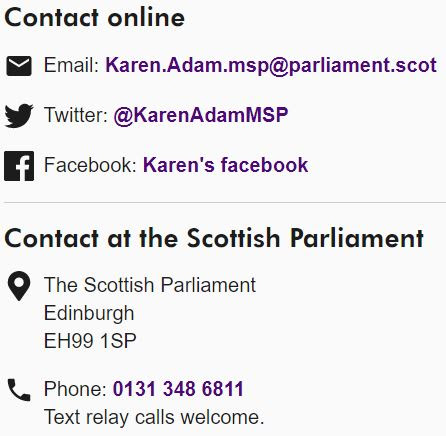The Scottish Government is looking to overhaul the current ferry fares system and replace it with a fairer Road Equivalent Tariff scheme which would bring cheaper travel for islanders, tourists and businesses across the country.
The pilot scheme will operate from October 19 until the spring of 2011 and will result in up to 50 per cent off fares.
Emerging findings from an independent research study to establish the most effective structure for a RET pilot confirm that:
- The pilot should operate on all the Western Isles to mainland routes
- A precise formula has been determined for a road equivalent tariff system. Cars and small vehicles should be charged a flat fee of £5 plus 60p per mile, rather than the current fare
- Passengers should be charged at £2 plus 10p per mile
- Goods vehicles should be charged at £20 plus 18p per lane metre per mile
- The new formula will result in up to 50 per cent off fares
- All ferry users will benefit from the reduction in fares - islanders, businesses and tourists
- The pilot should last 30 months to ensure it can be properly assessed and the policy subsequently developed to ensure it delivers maximum benefits for all
"For years, our remote and fragile communities have been expressing concerns about the affordability of ferry travel and the impact this has on islanders.
"Expensive fares can be damaging, not only to our local economies, but to our national economy, and this Scottish Government wants to take action.
"We believe the way forward is to consider the benefits of introducing a Road Equivalent Tariff (RET) approach to setting fares in Scotland.
"This pilot will examine that case - delivering cheaper fares for islanders, tourists and businesses.
"While initially focussing a pilot on the Western Isles, we want this test case to pave the way for cheaper fares for all our island communities.
"We will monitor the pilot closely and fine-tune it as necessary to ensure this scheme delivers maximum benefits for all.
"RET is a vision for the future of ferry fares, and this pilot could open the door to a fairer, cheaper system for every ferry user in Scotland. I would urge local authorities and the economic agencies to grasp this opportunity and build on the pilot for the benefit of the island economies.
"The Scottish Government wants to do all it can to boost island economies and deliver real improvements to our ferry services. I am sure this pilot will be a great success."
Peter Timms, Chairman of CalMac Ferries Ltd, said:
"We welcome the detailed clarification of the proposed scheme and now look forward to working with the consultants and with the Scottish Government to develop this into a robust framework which will be ready to apply from the start of our winter timetable in October.
"CalMac fully supports any initiative which will help regenerate the economies of the islands we serve, through increased traffic and affordable rates.
"The scheme as proposed brings significant challenges for CalMac, which I am certain we will overcome, however we will need some months to prepare the groundwork prior to its introduction. We are now clear what needs to be done and the process of changing our systems has already begun."
RET involves setting ferry fares on the basis of the cost of travelling an equivalent distance by road.
High ferry fares have been seen by many as a barrier to economic growth on the islands. Lowering the fares to a level analogous to mainland traffic costs could act as a boost to island economies by reducing freight costs to local businesses, lowering the cost of living for island residents and making the islands more attractive to tourists.
The routes for the initial pilot study will be: Ullapool - Stornoway, Uig - Tarbert (Harris)/Lochmaddy (North Uist) and Oban - Castlebay (Barra), Lochboisdale (South Uist) and Oban to Coll and Tiree.
The pilot will commence on October 19, 2008, the start of the winter timetable, until spring 2011. This will allow it to be fully assessed on its effectiveness, and to identify both positive and any possible negative implications of a RET scheme. This will include the gathering of traffic statistics and information from, for example, ferry users and local employers (including the freight and tourist sectors) designed to allow the impact of the pilot (especially in economic and social terms) to be assessed.
The study was carried out by experienced consultants specialising in transport and economics. They are recommending that the fares include a core cost plus an RET rate as set out below:
Passengers
Core rate: £2
RET rate: 10p per mile
Cars
Core rate: £5
RET rate: 60p per mile
Commercial Vehicles (CVs)
Core rate: £20
RET rate: 18p per lane metre per mile.
The 60p per mile rate suggested by the consultants is broadly comparable with the cost of running an average family car as identified by both the AA and RAC. Consultants also considered long-standing HMRC rates.
Table shows potential RET fares compared with current fares
RET | RET FARE | |||||
Route | Passenger | Car | CVs | Passenger | Car | CVs (Based on 10 metre vehicle) |
Oban to Castlebay/ | £10.95 | £48.33 | £212.75 | £21.95 | £81.00 | £332.52 |
Uig to Tarbert/ | £4.92 | £22.52 | £85.26 | £10.00 | £48.00 | £186.12 |
Ullapool to Stornoway | £7.22 | £36.32 | £133.90 | £15.30 | £75.00 | £264.43 |


 Born in 1946 and brought up in Cupar, Fife, I was educated at the local school -
Born in 1946 and brought up in Cupar, Fife, I was educated at the local school - 
















